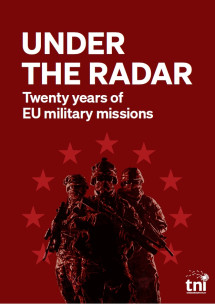HOW DOES THE AUTUMN STATEMENT AFFECT MILITARY SPENDING?
23 November 2023 by Stuart Parkinson
Dr Stuart Parkinson is Co-chair of the UK branch of the Global Campaign on Military Spending (GCOMS-UK) and Executive Director of Scientists for Global Responsibility (SGR).

Summary
In the Chancellor’s Autumn Statement, he confirmed that there had been a major rise – of 15% – in the UK’s core military spending last financial year. However, there are signs that the government’s enthusiasm for further growth is on the wane.
In more depth
The Autumn Statement 2023 (AS23)[i] revealed that the UK’s core military spending[ii] reached £52.8 billion[iii]in the financial year 2022/23. This was a massive 15.0% rise from the previous year, but slightly lower than that predicted in the Spring Budget (SB23).[iv] 88% of the rise was due to increases in spending on new military equipment. Most of the rise was to counter inflation, but by no means all. Core military spending during the two financial years, 2023-25, is planned to be lower, but this is largely due to a change in accounting practices rather than an actual cut in spending.[v] Table 1 summarises the latest figures and how these have changed since the spring.
Table 1 – A comparison of core military spending for 2021-25 as stated in Autumn Statement 2023 (AS23)[vi]and the Spring Budget 2023 (SB23)[vii]
| £bn (current prices[viii]) | 2021-22 | 2022-23 | 2023-24 | 2024-25 | Total |
| AS23 | 45.9 | 52.8 | 50.5 | 51.7 | 200.9 |
| SB23 | 45.9 | 53.1 | 50.9 | 51.7 | 201.6 |
| Change | -0.3% |
The figures for core military spending do not include military support to Ukraine which totalled £4.6bn for the financial years, 2022-24. The AS23 revealed that this was more than 13 times the value of humanitarian aid that the UK has so far pledged to the country[ix] – a huge and disturbing imbalance.
The core figures also do not include some other areas of military spending, for example, veterans’ pensions.
In the Chancellor’s Statement,[x] he confirmed that the government still intended to meet the NATO target to spend 2% of GDP on the military, but there was no mention of previous commitments to spend 2.25% by 2025 or 2.5% “in the longer term”. Given the very small reduction in the four-year budget for core military spending compared with the SB23 – see Table 1 – it would be premature to say that these targets have been abandoned, but they do not seem to have the priority they once had.
Comparing core military spending with other civilian departmental budgets continues to be revealing, as follows.
- In 2022/23, core military spending was 5.7 times the budget for the Foreign, Commonwealth and Development Office – which is responsible for the vast majority of the UK’s foreign aid budget. However, this ratio is expected to fall back to 4.4 this financial year, although this is partly due to a change in accounting practices at the Ministry of Defence (see above). It is especially notable that the government has decided to continue not meeting its target to spend 0.7% of Gross National Income on foreign aid,[xi] while still being committed to its NATO military spending target.
- In 2022/23, core military spending was 8.8 times the budget of the Department for the Environment, Food and Rural Affairs. Again, this ratio is expected to fall back this year – this time to 7.0.
- In 2022/23, core military spending was 8.9 times the budget of the Department of Energy Security and Net Zero – which is responsible for government spending on climate action. Again, this ratio is expected to fall back this year – this time to 6.6. However, recent government announcements to relax certain climate targets demonstrate that there remains a lack of commitment to action in this area, which is especially disturbing given the increasing severity of extreme weather around the world and the likelihood that the Paris climate targets will be missed.
One further point, the government announced new funding of £4.5bn for British manufacturing from 2025 for five years.[xii] The industrial sectors that will benefit included two which have especially high proportions of military applications, aerospace and nuclear.
In conclusion, there are small signs that the government’s fixation with increasing national military spending is on the wane, but this could change at any moment depending on the global geopolitical situation.
[i] HM Treasury (2023a). Autumn Statement 2023. https://www.gov.uk/government/publications/autumn-statement-2023
[ii] Core military spending is spending by the Ministry of Defence under its ‘resource’ and ‘capital’ budgets. It excludes certain other military budget lines as discussed in the main text.
[iii] All figures in this briefing are calculated from those on p33-36 of HM Treasury (2023a) – as note 1 – except where otherwise indicated.
[iv] p33-36 of: HM Treasury (2023b). Spring Budget 2023. https://www.gov.uk/government/publications/spring-budget-2023
[v] Further explanation of the change in accounting practices is given on p5 of House of Commons Library (2023). UK defence expenditure. https://commonslibrary.parliament.uk/research-briefings/cbp-8175/
[vi] As note 3.
[vii] As note 4.
[viii] ‘Current prices’ means that there has been no adjustment for inflation.
[ix] p28 of HM Treasury (2023a) – as note 1.
[x] HM Treasury (2023c). Autumn Statement 2023 speech. https://www.gov.uk/government/speeches/autumn-statement-2023-speech
[xi] p30 of HM Treasury (2023a) – as note 1.
[xii] p103 of HM Treasury (2023a) – as note 1.



